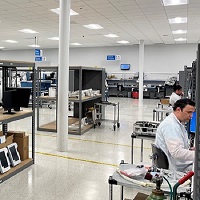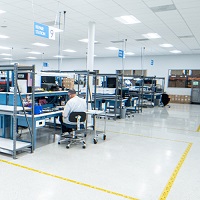
"Scaling Service Teams, Operations, and Reach" from Field Service Medical 2024
At the 2024 Field Service Medical conference in Huntington Beach, CA, professionals in the Service and Operations departments of medical device Original Equipment Manufacturers (OEMs) gathered to discuss the latest trends and strategies for maximizing their teams and budgets.
Quest International was there as well, sharing our expertise in Field Service, earned from more than 40 years of experience. Our Vice President of Global Service Solutions, Pasha Arshadi, spoke on a panel called “Scaling Service Teams, Operations and Reach” alongside Matthew Boyd of Medtronic and Christy Gaudet of Karl Storz. The three shared their thoughts on how OEMs can scale their operations by overcoming challenges related to technology, culture, and retention. They also discussed the benefits of using a third-party service provider to help alleviate many of the pain points associated with growing and maintaining a service organization.
The need for third-party help was clear to the panel, as was the need to be strategic about how to engage and deploy any partners. Boys shared that he asks himself the question, “Is this project short-lived where I can drive some resources and maybe strain other parts of the business or is this a new or longer-term strategy?” when determining whether to employ a partner. He stressed it is important to align the decision-making process with organizational goals and customer needs.
Arshadi pointed out that different companies have different needs to be fulfilled, from start-ups who are “trying to commercialize and get their product out to customers quickly” and “do not want to build the non-core service infrastructure” can leverage third parties’ existing operations to accelerate their push into the market. For partners like Quest, it is “our goal to kind of develop a system to be able to cater to our prospective customer’s needs to be able to solve those challenges that they may have,” said Arshadi. Partners can “get onboarded as if we were an extension of the organization that we're supporting… collaborating with our clients to ensure that we're installing best practices that they're implementing in their teams,” said Arshadi.
For many OEMs, their service organization is a big part of their brand and a reason why customers continue to purchase from them. And so, finding a partner who fits culturally and has the competency to adequately perform the tasks is a necessity. Said Gaudet, “I think it's table stakes that the partnership is invisible to our customers and that they never mention it. It is important to your brand that once you bring on an organization the image you present to your customer is completely seamless.” For her, the partnership is about “keeping that comprehensive 360-degree view of the customer, making sure we are deploying, onboarding, training. It ultimately comes down to communication and having strong processes laid out to govern the relationship.”
That ideal requires perfect integration of the partner, something that Quest has more than 40 years of experience with, and has the advantage of being ISO registered, allowing them to fit in with any Quality Management System. “And that's why I think it's a lot easier for us to integrate, because we're developing solutions that are uniquely developed for each of our clients. We're trying to fit it like a nice glove for every customer, who all have a different scenario in terms of how they want to partner. Our job is to build those teams and deliver to the standards that they want,” said Arshadi.
Beyond increased customer satisfaction, third-party partners can give insight into operations and best practices. “I know that when my team went and visited with [Arshadi’s] team, they came back with the strongest insights into what another service provider is doing. Especially for the larger companies, we get so caught up in our process and our day-to-day and our bureaucracy that we forget what some of these smaller or more nimble organizations are doing,” said Gaudet. Third-party partners can create a best practice that is the result of learning from many different customers, “We have a unique perspective because we work with a lot of different device manufacturers, small and large, so we get exposed to whatever they want us to do,” said Arshadi.
The talent and employment crisis regarding finding and keeping skilled Field Service Engineers was also a topic of conversation. Again, this is a strength of integrated service partners, “the unique difference from our standpoint is there is a lot more versatility with our resource team. Our field services teams are trained on a multitude of different devices, so that gives them a bit of excitement because they're doing something different and working on different types of technology - it's not going to be the same routine thing every time,” said Arshadi.
Trust is an important factor in the partner-OEM relationship and the panelists discussed how it is important for OEMs to have underlying agreements that shape the relationship. “How do you balance sharing knowledge with protecting yourself? I would say contractually that's where that is put in place. All of our third parties are under a confidentiality agreement, an NDA,” said Boyd. “But I would say I don't see that as an opposition to partnering with third party because like I said before, this is truly a partnership,” he added. Arshadi says that “going through due diligence and understanding how the partner operates is one of the things that you have to take into consideration when confidential things have to be implemented.”
Ultimately, the point of using a third-party for field service is to free up the OEM to focus on other tasks. “We come in and pick up the workload that somebody is going to do, whether it is planned maintenance or something else, and then allow their teams to focus on key activities. Now they have a lot more time for other priorities,” says Arshadi. Product iteration, market differentiation, and customer satisfaction can all be activities that can now be the focus of the OEM, while the partner handles maintenance.
Overall, the panel conversation provided valuable insights into navigating the complexities of service partnerships in the medical field, emphasizing collaboration, technology integration, talent management, and effective communication as key pillars of success.
More information:
To learn more about Quest’s services for medical OEMs, visit this page. If you are ready to talk to Quest about your repair needs, please fill out a form on our Contact page.
MAR-113 REV 1.0












